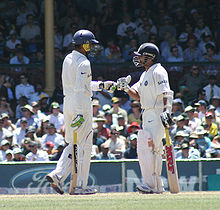- Helmet (cricket)
-
In the sport of cricket, batsmen often wear a helmet to protect themselves from injury by the cricket ball, which is very hard and can be bowled to them at speeds over 90 miles per hour (140 km/h).
There are recorded instances of cricketers using towels, scarves and padded caps to protect themselves throughout cricket history. Patsy Hendren was one of the first to use a self designed protective hat in the 1930s. Helmets were not in common use until the 1970s. Mike Brearley was another player who wore his own design. Tony Greig was of the opinion that they would make cricket more dangerous by encouraging bowlers to bounce the batsmen.
Graham Yallop of Australia was the first to wear a protective helmet to a test match on 17 March 1978 when playing against West Indies at Bridgetown. Later Dennis Amiss of England popularized it in Test cricket.
Helmets began to be widely worn thereafter. Nowadays it is almost unheard of for a professional cricketer to face a fast bowler without a helmet, and in under-19 cricket they are compulsory for all batsmen and any fielder within 15 yards (14 m) of the bat.
Cricket helmets cover the whole of the skull, and have a grill or perspex visor to protect the face.
Fielders who are positioned very close to the batsman (e.g. silly mid off) often wear a helmet and shin guards.
See also
- Batting helmet for baseball or softball
Cricket clothing and equipment Equipments Clothing Others Cricket nets • Snickometer • Hawk-Eye • Hot Spot • Category:Cricket equipment
Categories:- Headgear
- Cricket equipment
- Helmets
Wikimedia Foundation. 2010.

